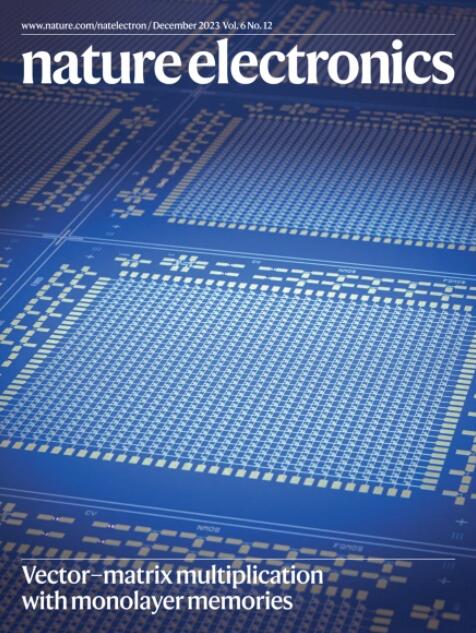Sub-stoichiometric zirconium oxide as a solution-processed dielectric for reconfigurable electronics
IF 40.9
1区 工程技术
Q1 ENGINEERING, ELECTRICAL & ELECTRONIC
引用次数: 0
Abstract
Reconfigurable devices that can switch functionalities could be used to overcome the limitations of miniaturized metal–oxide–semiconductor field-effect transistors. Conventional approaches typically involve the partial electrostatic modulation of two-dimensional semiconductors and use partial floating gates or dual-gate structures. Reconfigurable devices based on vertical van der Waals heterostructures have much simpler device structures, but lack a scalable assembly method. Here, we report a scalable reconfigurable device based on solution-processed van der Waals heterostructures. We vertically assemble thin films of sub-stoichiometric zirconium oxide (ZrO2-x) as a dielectric and molybdenum disulfide (MoS2) as a semiconductor layer. The ZrO2-x/MoS2 heterostructure provides simultaneous global and local gating within a single-gate transistor configuration, modulating the spatial electric field across the device in a reconfigurable manner. Under global gating conditions, the devices function as uniform field-effect transistors with an average field-effect mobility of 10 cm2 V−1 s−1 and current on/off ratio of up to 106. Under local gating conditions, the devices function as diodes, exhibiting a current rectification ratio of around 7 × 104. By harnessing the reconfigurable characteristics, we achieve adjustable temporal photoresponse dynamics with a photoresponsivity of around 105 A W−1, high spatial uniformity and multi-spectral photodetection. We also use the approach to create a large-area reconfigurable optoelectronics array. Devices based on a vertical van der Waals heterostructure of solution-processed zirconium oxide and molybdenum disulfide can reconfigure between transistor and diode modes, and be fabricated on the wafer-scale.


亚化学计量氧化锆作为溶液处理的可重构电子介质
可以切换功能的可重构器件可以用来克服小型化金属氧化物半导体场效应晶体管的局限性。传统的方法通常涉及二维半导体的部分静电调制,并使用部分浮栅或双栅结构。基于垂直范德华异质结构的可重构器件具有更简单的器件结构,但缺乏可扩展的组装方法。在这里,我们报告了一种基于溶液处理范德华异质结构的可扩展可重构器件。我们垂直组装亚化学计量氧化锆(ZrO2-x)薄膜作为电介质和二硫化钼(MoS2)作为半导体层。ZrO2-x/MoS2异质结构在单栅极晶体管配置中提供同时的全局和局部门控,以可重构的方式调制器件上的空间电场。在全局门控条件下,器件作为均匀场效应晶体管工作,平均场效应迁移率为10 cm2 V−1 s−1,电流开/关比高达106。在局部门控条件下,器件发挥二极管的作用,显示出约7 × 104的电流整流比。通过利用可重构特性,我们实现了可调的时间光响应动力学,光响应率约为105 a W−1,高空间均匀性和多光谱光探测。我们还使用该方法创建了一个大面积可重构的光电阵列。
本文章由计算机程序翻译,如有差异,请以英文原文为准。
求助全文
约1分钟内获得全文
求助全文
来源期刊

Nature Electronics
Engineering-Electrical and Electronic Engineering
CiteScore
47.50
自引率
2.30%
发文量
159
期刊介绍:
Nature Electronics is a comprehensive journal that publishes both fundamental and applied research in the field of electronics. It encompasses a wide range of topics, including the study of new phenomena and devices, the design and construction of electronic circuits, and the practical applications of electronics. In addition, the journal explores the commercial and industrial aspects of electronics research.
The primary focus of Nature Electronics is on the development of technology and its potential impact on society. The journal incorporates the contributions of scientists, engineers, and industry professionals, offering a platform for their research findings. Moreover, Nature Electronics provides insightful commentary, thorough reviews, and analysis of the key issues that shape the field, as well as the technologies that are reshaping society.
Like all journals within the prestigious Nature brand, Nature Electronics upholds the highest standards of quality. It maintains a dedicated team of professional editors and follows a fair and rigorous peer-review process. The journal also ensures impeccable copy-editing and production, enabling swift publication. Additionally, Nature Electronics prides itself on its editorial independence, ensuring unbiased and impartial reporting.
In summary, Nature Electronics is a leading journal that publishes cutting-edge research in electronics. With its multidisciplinary approach and commitment to excellence, the journal serves as a valuable resource for scientists, engineers, and industry professionals seeking to stay at the forefront of advancements in the field.
 求助内容:
求助内容: 应助结果提醒方式:
应助结果提醒方式:


